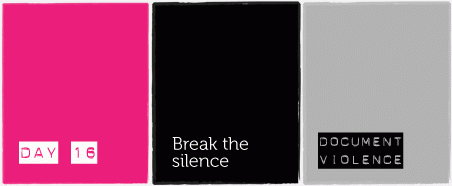
Despite the prevalence of violence against women, we've come to live with it as a normal part of everyday life. Especially since violence against women is often perpetrated by people known to the survivors, many of us tend to ignore the fact that someone we know is being abused or violated. We are nervous about being accused of intruding into someone's private life. Or that it is none of our business.
Shame and stigma that surround certain types of violence, especially those related to sexuality and sexual rights, also make it difficult for women and girls to come forward and report the violence that they have faced. Often, they encounter further violence by police officers, the media and others who place the blame on them instead of making the abuser or perpetrator accountable for their actions.
As a result, the violation of women's human rights and the violence that women and girls face continue as an everyday occurrence in our realities.
Today is the last day of the 16 Days of Activism against gender-based violence, and it falls on 10 December, Human Rights Day. Mark it by making a commitment to begin documenting the violation of women's human that takes place through acts of violence. Document, make it visible and break the silence around violence against women.
Violence against women and ICTs
We are only beginning to understand the different ways that information and communication technologies (ICTs) intersect with violence against women. Cases of online harassment, cyberstalking, domestic abuse over the use of mobile phones and more are slowly emerging. Many countries still do not have laws and measures to first, recognise them as acts of violence against women, and secondly to provide legal justice and redress. Existing laws around child pornography and spam are being used awkwardly to fit around reported cases, but do not adequately address the protection of women's right to privacy, expression, information, mobility or safety.
Contribute to the work of women's rights movements to document and understand the breadth and forms of violence against women that takes place in digital spaces, and or through the use of ICTs. Support the development of laws and responses that are grounded in the human rights of women. Break the silence.
Document the violence
Share your experience and knowledge on forms of violence against women that are connected to ICT.
This can be something that you have experienced yourself, an incident that you heard of, or something that you have read in the news. Every story is important.
Map it!
- Create an account on this site and log in.
- Click on "Create Content" > "Map - vaw".
- Title: Describe the violation in a brief sentence
- Type of vaw: Tick the type of violence which took place. The options provided are summarised based on the forms of violence against women ICT encountered on a research that was undertaken in 12 countries:
- Blackmail: This is where personal or shared information such as private photographs are used to blackmail or threaten another person. Many women are trapped in violent relationships because their husband or partner has intimate video clips or photographs of them and threaten to publish or share them, keeping the women under their control.
- Impersonation or identity theft: For example, pretending to be someone to communicate with people on her contact list, using someone's name or photograph to post soliciting messages including her personal detail like phone number or home address, using a partner's or former partner's personal details to withdraw money from her bank account etc.
- Harassment and threats: For example, frequent, unsolicited messages or calls from someone, usually sexual in nature, or threatening messages that are makes someone fear for her safety. These are some of the most common forms of online harassment. A survey carried out in Pakistan in 2009 revealed that one in ten women received threats from strangers.
- Stalking, tracking and/or monitoring of online and offline activity: For example, keeping a history of someone's web navigation activities to see if she is seeking help or who she is communicating with, installing GPS devices or subscribing to services by mobile service providers to track her location, or going through someone's SMS or emails etc. This is one of the most common ways that abusive intimate partners misuse technology. In the space of two weeks in December 2008, there were two reports in Uganda of men who murdered their wives after they accused them of receiving "love messages" through SMS.
- Other: These are just some of the more frequent types of vaw that we have encountered. Tick this if none of the options above fit the experience that you are documenting.
- Tools used: Select what types of ICT were used in perpetrating the act of violence against women, or where the violence took place.
- Details: Briefly describe what happened.
- Location: Plot the location of where it happened by clicking on the map. You can change the location by clicking on the marker and dragging it. You don't have to disclose exactly where the physical location is, just click anywhere you feel is central to the country or region where it took place.
- Country: Select which country by scrolling down.
- Click "Save" and your story is now documented on the map.
- Or email us your story at ideas AT takebackthetech.net, and we will map it for you.
- Know more by exploring the map here, and post some comments of support and solidarity!
Make everyday a day to defend and protect human rights. Keep documenting. Break the silence and turn violence against women from our normality, into an anomaly. Take back the tech!
- Log in to post comments
